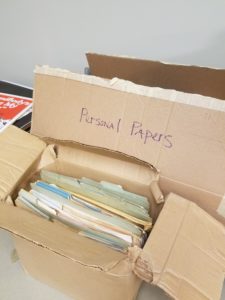(Note: This post was authored by Taylor McNeilly, Processing & Reference Archivist.) There is a darker side to processing any collection. One that archivists often try not to talk about. It’s dark, it’s dirty, and it doesn’t always make for good PR. But it’s almost always necessary. This week’s #WyattWalkerWednesday post is about that darker side. This week, I’m going to talk about…moldy material.
Moldy material comes in with a lot of collections. And even in collections where there isn’t any mold, it’s an archivist’s solemn duty to check the collection carefully. Mold is incredibly commonplace and can easily grow on almost any surface. Your first thought is probably moldy paper, but photographs, textiles (clothing and the like), posters, even some digital media storage formats (usually magnetic tape, so floppy disks) can house mold. And anything anybody has ever eaten something near or held in unclean hands can end up moldy. Because not every single human being on the planet is an archivist obsessed with the long-term preservation of every document or object they come in contact with, it’s a safe assumption that at least some of the material in any collection may have come in contact with food or otherwise been exposed to mold.
Mold also spreads incredibly easily. This means that, should an object with mold be moved into a storage space with other archival collections, it can contaminate and infect all the other material around it. This can destroy an entire archives, if left unchecked. Archivists are of course very vigilant about ensuring this never happens.
The Walker Collection is no exception to this constant fear of mold. Because some items in the collection date as far back as the 1950s, and since the items weren’t kept in archival conditions for their entire 60+ year lifespan, there’s a high fear of mold. Because of this, and because of the sheer size of the donation, the material was held offsite until we could check it for mold and bring it on-site for processing in chunks. This week, I spent about 3 hours in off-site storage with Lynda, the Head of Rare Books and Special Collections, sorting through previously unchecked material in the collection. It was hot, dusty, dirty work. But we were successful! Lynda and I managed to look through all the remaining material for contamination, and we brought back a car load of manuscript material to continue processing.
While there was some contaminated material found that has to be separated from the rest of the collection, this material is not immediately thrown away. Typically when an archivist finds moldy items, the material is put into a quarantine where it can be observed over time to help us see whether it is active or inactive. From there, an archives can take different remediation steps to hopefully salvage the material and reintroduce it to the collection. This can include freezing the material, cleaning it thoroughly, and maintaining specific environmental settings (relative humidity and temperature) to inhibit mold spore activation and growth. If the mold is found to be already inactive, many of these steps can be foregone and reintroduction to the main collection can occur.
Because it takes time to see if the mold is active or inactive, we won’t be able to tell for a little while what damage might have been done. Mold is also often mistaken for what’s called foxing, a natural process in paper that occurs as it ages, leaving brown dots, spots, and stains on the paper. This is neither contagious nor dangerous for the paper, and the mistaken identification goes both ways. That is to say, many of the materials Lynda and I quarantined for fear of mold may in fact just be foxed, meaning it can be added back into the collection almost immediately. Only time will tell.
So there you have it: the dark, dirty business including in the processing of any collection. With luck, we’ll be able to identify any active mold in the items we’ve quarantined by the end of summer and begin working towards cleaning and reintroducing them to the rest of the collection. In the meantime, there’s plenty of clean manuscript materials to process, so I’m sure I’ll be busy no matter what!


Pingback: Further SCLC Records | Something Uncommon